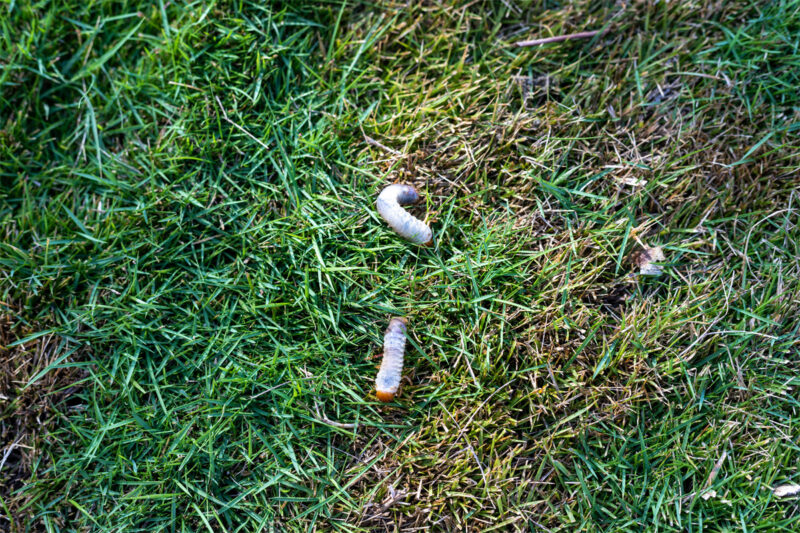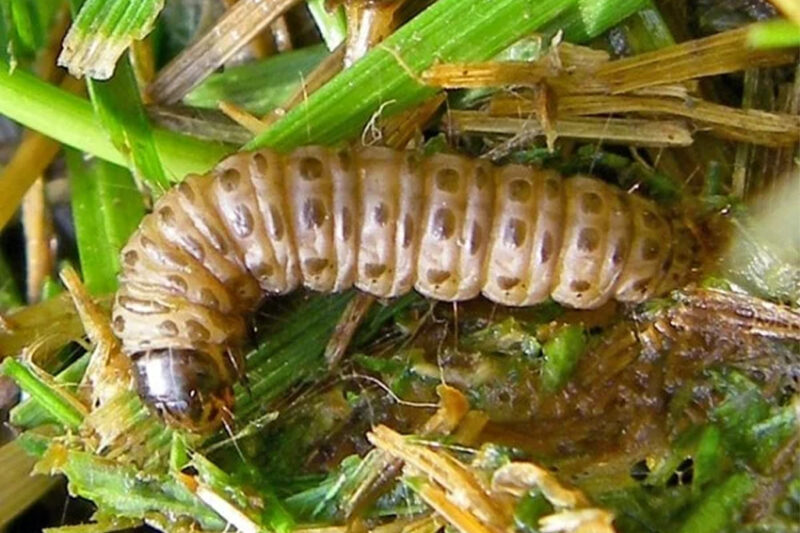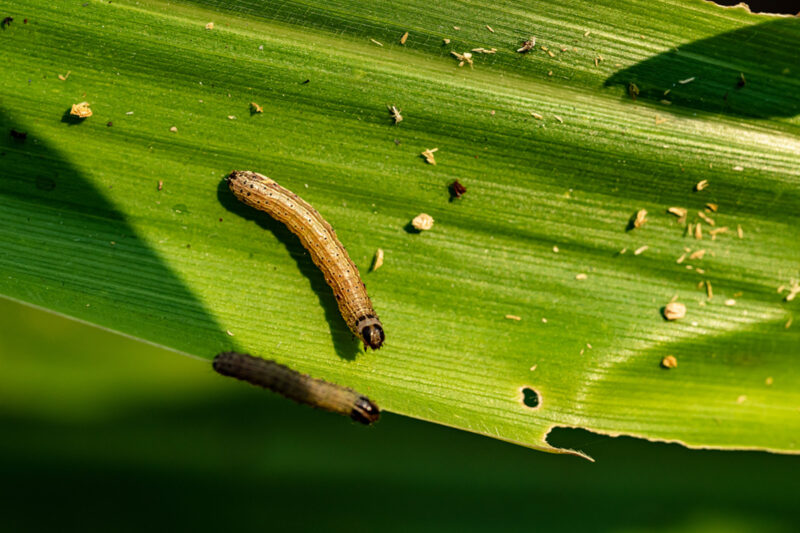
Are ruthless insects running rampant through your luscious green lawn? Not only are those little intruders annoying, they can kill your grass and cost you hundreds of dollars in reseeding. In some cases, pests are just the start of the problem and can also lead to lawn disease. As a trusted Wichita lawn care company, Elite Landscape Solutions can help you identify and treat common lawn pests in Kansas.
Grub Worms (White Grubs)

Appearance:
Circular brown patches are a telltale sign of brown patch (Rhizoctonia Solani) disease. These patches are often the disease themselves. As the name suggests, brown patch disease discolors grass and typically creates a muted olive green or brown patch on lawns. After the infection takes hold, leaf blades turn brown and you may also see white streaks or bands around the patches.
Types of Damage:
A fungus called Rhizoctonia Solani causes brown patch disease in cool-season grasses and turf grasses. The fungus thrives during hot, humid conditions in the summer, which activate the pathogen the fungus carries. Lawns with high nitrogen are also more susceptible to the fungus because the nitrogen-rich soil feeds the pathogen, leading to a more severe outbreak.
Signs of Infestation:
You can start treating brown patches by improving airflow and circulation around affected areas. This involves raking the soft, spongy thatch or using aeration to create small holes to promote airflow. Improving circulation helps prevent the pathogen from spreading to healthy grass. Applying fungicide is another effective way to treat the problem. However, we recommend contacting a professional landscaper to make sure you choose the correct treatment. Lastly, make sure not to overwater or over fertilize as both of these can strengthen the pathogen.
Control and Prevention:
Preventing and treating brown patch disease involve similar strategies. You can reduce the chances of infection by improving air circulation and avoiding overwatering. Other methods like properly mowing help you catch the disease early and stop fungal buildup near the soil. Fertilizing in the spring and fall is another great rule of thumb, this stops the fungus from growing during damp periods and keeps your lawn healthy.
Chinch Bugs

Appearance:
Chinch bugs are tiny insects measuring only about ⅙ of an inch long which is about the size of a sesame seed. Their oval-shaped black bodies and milky white wings are typically difficult to spot unless you see them move. However, adult chinch bugs often have an hourglass shape on their backs, making them fairly distinct from other pests.
Types of Damage:
Chinch bug damage starts at the grass blades. They drain the sap from the blades and inject toxins, eventually killing the grass. Over time you’ll see the affected grass turn sickly yellow and then, once it dies, fade to a dusty brown. The damage can frequently resemble drought stress as well as other types of common pest damage.
Signs of Infestation:
At first, you may confuse chinch bug infestations with other types of pest damage or common lawn fungi like brown patch disease. You might notice scattered patches of pale yellow or dried brown grass. Some other signs of chinch bugs include irregular shapes in your grass similar to those of fairy rings and increased ant activity around the dead patches.
Control and Prevention:
To keep chinch bugs at bay, maintain a healthy lawn through practices like deep watering and mowing at the correct height for your grass type. Insecticides can be an effective control option, but it’s important to choose products specifically targeted at chinch bugs and follow the label instructions carefully. Preventive measures, such as reducing thatch and promoting beneficial insects, can help minimize the risk of future infestations.
Sod Webworms

Appearance:
Sod webworms, also known as lawn moths, are tiny caterpillar-like worms with grayish-tan bodies with dark brown spots. Their heads are typically darker than the rest of their body. Fully grown larvae are around ¾ to 1 inch long or about the size of a paperclip or fingernail. However, young larvae are even smaller at only ⅛ of an inch, making them difficult to spot.
Types of Damage:
Known for their large appetites, sod webworms are notorious for attacking grass blades. Over time, their feeding pattern can create small brown patches of grass that eventually merge with other patches. This can leave your lawn looking thin and jagged like a bad haircut. With enough time, though, sod webworms can eventually kill your lawn completely since they prevent nutrients from reaching the entire grass blade.
Signs of Infestation:
While webworms can be sneaky, they do leave behind a few clear signs of infestation. Most outbreaks start with small, ragged brown patches that spread quickly. Small moths fluttering around at dusk are another sign of sod webworms. These moths are the adult versions of the webworm that leave silken grass tunnels in the evening.
Control and Prevention:
To keep sod worms from damaging your lawn, we recommend using a combined approach. Proper lawn care practices are always helpful as they reduce stress on your lawn. As always, insecticides should be used cautiously. According to the University of Nebraska, before using insecticides, homeowners should mow their lawn, bag the clippings and water ½ to ¾ an inch to move the worms closer to the surface. This will increase how effective the solution is and protect good insects.
Armyworms

Appearance:
Armyworms are deceptive: they may look like harmless little caterpillars, but in reality they are much worse. The fully grown larvae are around 1.5 to 2 inches in size and often vary in color from an olive green to a muted, neutral brown. Homeowners often mistake armyworms for caterpillars; however, they have distinct black dots and stripes lining the sides of their body.
Types of Damage:
Armyworm damage can be dramatic and quick. Like other lawn pests, armyworms attack the grass blades directly, severing them, and leaving your lawn a thin, raggedy mess. However, unlike other pests, armyworms eat the entire grass blade, typically only leaving behind the whitish skeletal veins. Additionally, armyworms tend to feed in large groups. This is how they cause significant damage like defoliation and thinning.
Signs of Infestation:
While armyworm damage is swift and obvious, the first signs are subtle and often overlooked. Damage usually starts with small brown patches of grass like other pests, but these patches spread quickly making them a serious threat to your entire lawn. Keep an eye out for visible caterpillars and an increase in birds around your lawn that are drawn to armyworms and often hang around to snack on the pests.
Control and Prevention:
The University of Minnesota estimates a single armyworm moth can produce over 1800 eggs in just a matter of days. With so many possible pests in one area it’s critical that homeowners practice proper lawn care to keep their grass healthy. Additionally, insecticides with active ingredients like chlorantraniliprole or spinosad are great at fighting armyworms, although timing is still important. To prevent damage, use insecticides while the worms are young and small, typically in late summer and early fall. Remember: the sooner you detect an infestation the better. Keep an eye out for brown patches in your lawn and strange-looking caterpillars.
Effective Lawn Pest Control From Elite Landscape Solutions
From tiny chinch bugs to vicious armyworms, Kansas lawn pests can seriously damage your grass. By identifying the signs of infestation and acting quickly, you can fight back against those little intruders. If you’re in the Wichita area, you can rely on Elite Landscape Solutions for effective lawn pest control. Request a free estimate today and we’ll help you identify and treat common lawn pests with unmatched expertise.
